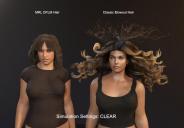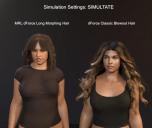Question about different types of dForce Hair
 nwleee_a52bfead84
Posts: 108
nwleee_a52bfead84
Posts: 108
in The Commons
Most of the long or medium dForce hair that I own has a very effective dForce simulation. But a few of these hair props don't seem to move much at all when clearing or simulating them.
If you take a look at the two samples below, you can see that the Long Morphing Hair barely moves during clearing/simulating. As opposed to the Classic Blowout Hair, which raises way up into the air for a full, accurate simulation. Both hair props used the same simulation settings.
Can someone help me out with this? Why can't I get the Long Morphing Hair to react more to the simulation settings?
Thanks!


Imager 01.jpg
1066 x 741 - 143K


Image 2.jpg
875 x 738 - 129K


Comments
Some dForce hair is using the dForce feature for strands and isn't intended to simulate, so its strength is set very low or to zero. Having morphing in the name does imply that the hair is to be adjusted via morphs, rather than simulated.
Okay, thanks for the explanation Richard. I appreciate it.
I don't suppose there is any way for the end-user to adjust the simulation strength?
I know the hair has presets for how much "pull" is applied to the hair....but I'm not really sure what that function is for, or if it would help me get the hair in a good position.
Also note, that on top of what Richard has said, that the two hairs you highlighted are based on quite different technologies. The MRL hair is fibermesh and uses the dForce hair introduced into Daz Studio a year or two back. The blowout hair is a more traditional polygon hair that use the dForce cloth engine in order to run the simulation.
Both types of tech have their advantages and disadvantages, but in my experience the ones using the cloth engine will typically move further and faster than the fibermesh ones. This is particularly true of Linday's hairs, like the classic blowout you have been using. For some reason a lot of PAs put quite restrictive weightmaps on their dForce hairs that restricts their movement. I am guessing they did this to keep the hair together for more normal poses, but they tend not to work well with more extreme poses like when the head is held well back, or even downwards. In those cases a cloth engine hair might do a better job, but I have seen fiber mesh hairs that can also handle those types of poses.